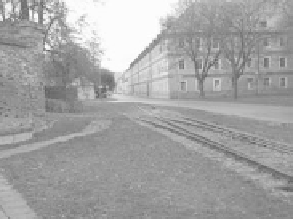Travel Reference
In-Depth Information
to bring in water. The
shower room
farther to the left, on the other
hand, was used to fool the Jews. Here they got used to the idea
of communal bathing—so they wouldn't be suspicious when they
were later taken to similar-looking installations at Auschwitz.
(here were no gas chambers at Terezín—most of the deaths here
were caused by malnutrition and disease, and to a lesser extent,
executions.)
Before the Nazis, the Small Fortress was used as a prison by
the Austrian Monarchy. The little courtyard preserves the cell of
the most famous prisoner from that time, the Bosnian Serb
Gavrilo
Princip,
whose assassination of Archduke Franz Ferdinand and
his wife Žofie in 1914 sparked World War I. Princip died here in
1918 of tuberculosis.
Return through the
Arbeit Macht Frei
gate, then turn left
into a large courtyard. On your right is an
U
art museum
with
two floors of paintings by prominent Czech artists, with themes
of camp life and the Spanish Civil War. Farther to the left is a
path leading to the
I
execution ground
and a
mass grave
of the
victims.
To take a break or finish your tour at this point, you could
head to the handy cafeteria by the entry gate to the Small Fortress.
The wood-and-metal chandeliers inside were produced by Jewish
workers for the SS officers who once dined in these two rooms.
With more time, consider continuing your tour in Terezín
town with the less-frequented sights, described below, that lie
along or just off a main road called Dlouhá. At Dlouhá 17 look
for the unique
O
hidden synagogue,
the only one of the camp's
eight synagogues that survived. Although entry is included with
your combo-ticket, you may need to ring the bell for the guard to
open the door. Inside you'll find a courtyard; the bakery that used
to be here hid the synagogue behind it. The atmospheric space is
still inscribed with two Hebrew captions, which are translated as:
“May my eyes behold, how You in compassion return to Sinai,”
and “If I forget Jerusalem, may my tongue rot and my right arm
fall off.” These words indicate that the prayer room belonged to
a congregation of Zionists (advocates of a Jewish state), who, one
would expect, were specifically
targeted by the Nazis.
Continue down Dlouhá
to the Bohušovice gate. On the
ground you will see the remnants
of
A
railway tracks.
In the early
years of the camp, Jews arrived
at the train station in the nearby
town of Bohušovice and then had
to walk the remaining two miles




















